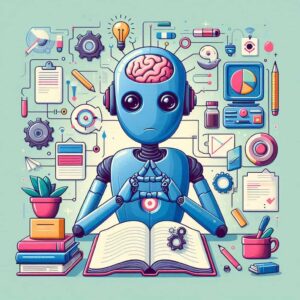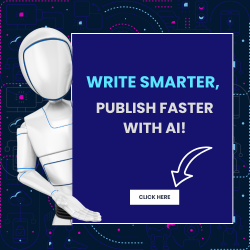
How to Write a Story with AI: A Comprehensive Guide
- Writing Enhancement

The Transformation of Storytelling with AI
In today’s rapidly evolving world of storytelling, you might be wondering: can AI actually help me write a story? The answer is a resounding yes! AI tools are becoming increasingly sophisticated, capable of generating creative ideas, crafting compelling narratives, and even producing stunning visuals to bring your stories to life. But while AI can be an invaluable asset, it’s crucial to understand both its potential and limitations. Keep reading to learn how you can effectively use AI to enhance your storytelling without sacrificing your unique voice and creative vision.
Understanding AI Storytelling
AI storytelling refers to using artificial intelligence to assist in the creation of narratives, characters, and plots. This technology relies on advanced algorithms and language models to generate stories, offer creative suggestions, and enhance the overall storytelling experience.
The Technology Behind AI Storytelling
At the core of AI storytelling tools are complex algorithms powered by vast amounts of data and machine learning. These tools are trained on massive datasets of text, code, and even images, allowing them to learn the patterns, structures, and styles that make a story compelling.
Popular AI Storytelling Tools
- Large Language Models (LLMs): These sophisticated programs, such as GPT-3 and ChatGPT, can understand and generate human-like text.
- AI Story Generators: Platforms like Storytell.ai offer user-friendly interfaces that guide writers through the process of creating narratives.
- AI Writing Tools: Tools like Jasper are designed to help writers with specific tasks, such as generating dialogue or composing different sections of a story.
Benefits of Using AI for Storytelling
AI storytelling tools can act as digital co-writers, offering creative support that enhances the writing process in several ways. Here are some key benefits:
Overcoming Writer’s Block
AI can be a lifesaver when you’re staring at a blank page. By analyzing countless stories, it can generate unique plots, intriguing settings, and diverse characters, helping you overcome creative blocks and spark fresh ideas.
Enhancing Creativity and Exploring New Ideas
AI can push you beyond your usual writing boundaries, encouraging you to explore new genres, styles, or themes you might not have considered otherwise.
Speed and Efficiency in Content Creation
AI can significantly speed up your writing process by generating quick drafts, whether it’s dialogue, scenes, or even entire chapters. This efficiency allows you to focus on refining your narrative rather than starting from scratch.
Crafting Visuals and Immersive Experiences
AI tools like DALL-E or Midjourney can generate images of characters, landscapes, and key scenes, enriching the storytelling experience and aiding in world-building. Some AI tools can even help create interactive elements, adding a new dimension to storytelling.
Limitations of AI in Storytelling
While AI offers incredible potential, it’s essential to recognize its limitations. Remember, AI is a tool, not a replacement for the human storyteller.
The Importance of the Human Touch
AI cannot replicate the nuances of human experience or emotions. Stories that deeply resonate with audiences require empathy, understanding, and insights drawn from real-world experiences – qualities that AI currently lacks.
Lack of Emotional Depth and Context
AI struggles to convey genuine emotion, understand subtle humor or sarcasm, and capture the complexities of human relationships. It can create grammatically correct and coherent text, but it often lacks the soul and emotional depth that make a story truly engaging.
Originality Concerns and Potential for Bias
Because AI learns from existing data, there’s a risk of it generating repetitive or derivative content. It’s crucial to ensure that AI-generated content is original and reflects your unique voice. Additionally, it’s important to be mindful of potential biases that may be present in the data used to train AI, and to ensure that AI outputs are fair and inclusive.
How to Effectively Use AI for Storytelling
To harness the power of AI while mitigating its limitations, follow these strategies:
Start with a Clear Outline and Concept
Before you even open an AI tool, have a solid understanding of your story’s structure, the message you want to convey, and the emotions you want to evoke.
Master the Art of Prompt Engineering
The quality of the output you get from AI largely depends on the prompts you provide. Experiment with different keywords, phrasing, and levels of detail to find what generates the best results for your story.
Refining and Editing AI-Generated Content
Think of AI as a first-draft generator. Treat its outputs as raw material that needs to be carefully reviewed, edited, fact-checked, and infused with your own creativity and emotional intelligence.
Experimenting with Different Techniques and Tools
The world of AI storytelling is constantly evolving. Don’t be afraid to explore various AI platforms, experiment with different prompt styles, and find what works best for your specific storytelling needs.
Finding the Right Balance Between AI and Human Input
Use AI as a supportive partner, not a crutch. Allow it to spark your imagination, generate ideas, and speed up your writing process, but always maintain control over the narrative and ensure that your unique voice shines through.
Examples and Case Studies of AI in Storytelling
AI is already making waves in various storytelling mediums. Here are a few compelling examples:
Video Games
Games like “RimWorld” utilize AI storytellers to generate dynamic scenarios and events based on player choices, creating emergent narratives that enhance the gaming experience.
Marketing and Advertising
AI is increasingly used to generate engaging content for marketing campaigns. AI-powered tools can craft personalized narratives that resonate with specific target audiences, leading to increased brand awareness and customer engagement.
Co-Authored Novels
Some authors have partnered with AI to co-write novels, using AI to generate drafts or explore different plot possibilities. This collaboration allows writers to tap into new creative avenues while maintaining their unique storytelling style.
The Future of AI in Storytelling
As AI technology continues to evolve, its impact on storytelling will only grow more profound. We can anticipate even more innovative applications, such as:
Personalized Narratives
AI algorithms will be able to analyze individual preferences and tailor stories to specific readers or viewers, creating deeply personalized experiences.
Interactive Storytelling
AI will enable narratives that respond to audience input, blurring the lines between creator and consumer and leading to truly immersive storytelling experiences.
New Storytelling Formats
AI has the potential to create entirely new ways of telling stories, using combinations of text, visuals, audio, and interactive elements that we can only begin to imagine.
Conclusion: Embracing AI in Storytelling
The world of storytelling is on the cusp of a remarkable transformation, fueled by the power of AI. While it’s important to be aware of the limitations of AI, its potential to enhance creativity, inspire new ideas, and expand the boundaries of storytelling is undeniable. By embracing AI as a collaborative partner and wielding its capabilities thoughtfully, writers and creators can unlock a world of narrative possibilities and bring their stories to life in ways never before imagined. The future of storytelling is brimming with potential, and AI will undoubtedly play a pivotal role in shaping its exciting evolution.
Using Positive Reinforcement to Enhance Writing Skills
To address the search intent of “how to use positive reinforcement to help someone write a story,” here’s a practical, step-by-step training:
Understanding Positive Reinforcement
- Definition: Positive reinforcement is a technique used to increase desired behaviors by rewarding them. In this context, it’s about encouraging someone’s writing efforts and progress.
- Benefits: This method helps build confidence, motivation, and a positive association with the writing process. It focuses on what the person is doing well, rather than solely highlighting areas for improvement.
Step-by-Step Training
1. Set Clear and Achievable Goals
- Collaborate with the individual: Instead of imposing goals, work together to define what they want to achieve with their writing.
- Break down larger goals: Divide a big project like writing a novel into smaller, manageable tasks.
2. Identify and Reward Positive Behaviors
- Acknowledge effort: Praise their dedication to writing, regardless of the outcome.
- Celebrate milestones: Offer specific praise for accomplishments.


